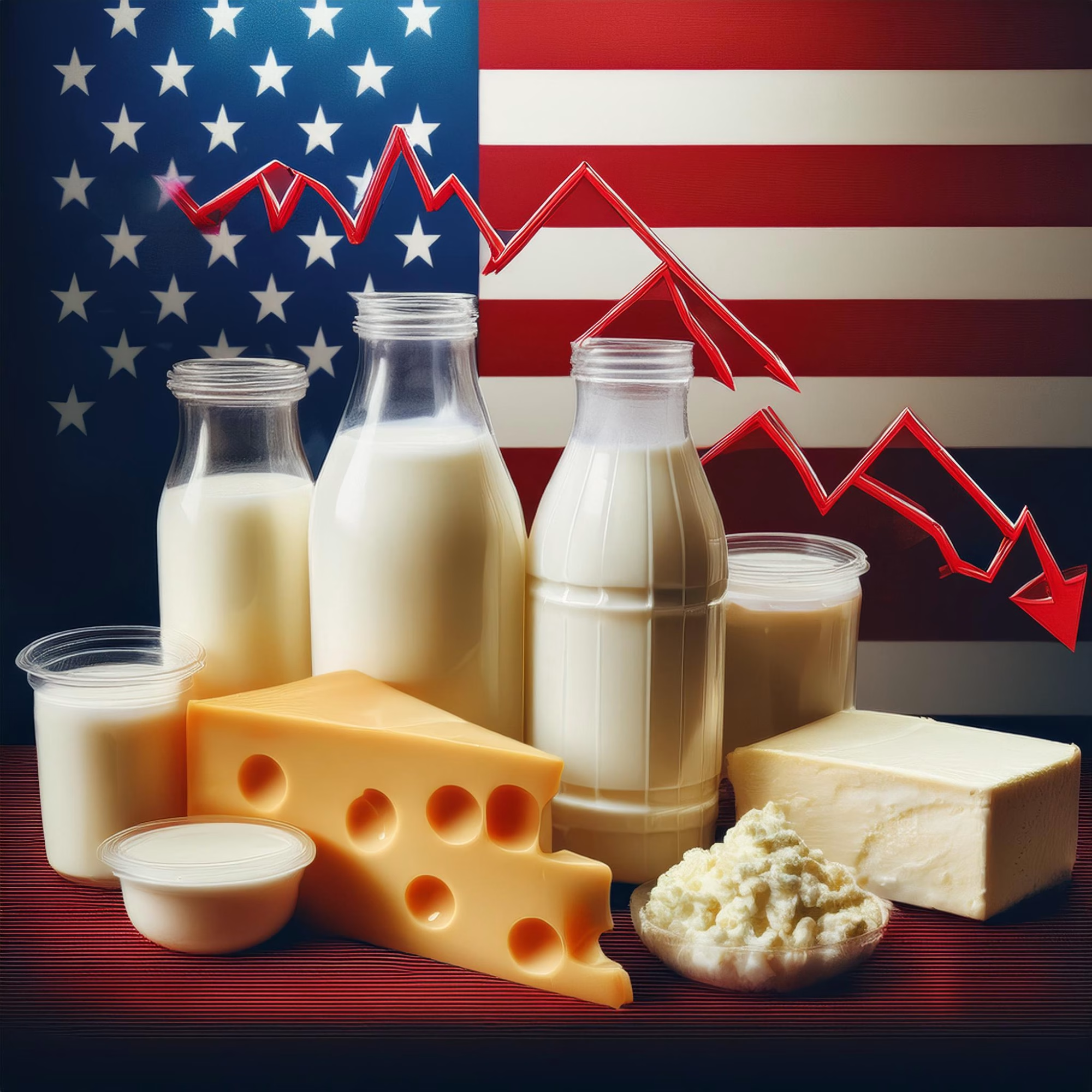Is the U.S. running out of milk? Find out the troubling trends impacting dairy farmers and the future of milk production. Read more now.
Summary: Brace yourself, dairy farmers, for a deep dive into the latest trends shaping our industry. July 2024 has ushered in a subtle yet significant shift in U.S. milk production, marking the thirteenth consecutive month of decline. The USDA’s recent report shows a 0.4% decrease year-over-year, with the major milk states producing 18.171 billion pounds—a slight dip from July 2023. Despite a minor increase in production per cow, the overall number of milked cows decreased, driving this downward trend. California still tops the charts, but Texas surprises with a notable production boost. In July, the top 24 states saw a reduction in output by 0.2%, although per-cow productivity rose slightly. Key states like California and Idaho recorded drops, but Texas outperformed with a 6% rise in output due to herd expansion and better yields. Factors like tight heifer supplies, high beef prices, and hot summer temperatures are complicating herd expansion, pushing dairy commodity prices upwards. So, what’s really happening on our farms, and how can we navigate this complexity? Let’s explore.
- US milk production continues to decline, marking the thirteenth consecutive month of reduced output.
- USDA’s report shows a 0.4% decrease in year-over-year production in July 2024, with a total of 18.171 billion pounds.
- Despite a slight increase in per-cow production, a reduction in the number of milked cows is driving the downward trend.
- California remains the top producer, while Texas saw a surprising 6% increase in milk production due to herd expansion and improved yields.
- Tight heifer supplies, high beef prices, and hot summer temperatures are complicating herd expansion efforts.
- Dairy commodity prices are rising, affected by the tight supply and challenging conditions faced by producers.

Did you know that in July 2024, the United States experienced a significant 0.2% decrease in milk output? According to the USDA, the top 24 milk-producing states produced 18.171 billion pounds of milk, reflecting a subtle but impactful shift in the industry. As our dairy herd diminishes and climatic conditions change, we can’t help but worry about what the future holds for the dairy sector. “The USDA reduced its 2024 and 2025 milk production forecasts, suggesting that the sector may face more problems. Stay ahead by being informed.” — USDA Report for August 2024. As dairy producers, understanding the milk production environment helps us negotiate the complexity of our profession. So, let’s talk about what’s going on and what it implies for you and your farm.
| Month | Milk Production (Billion Pounds) – 2023 | Milk Production (Billion Pounds) – 2024 | Year-over-Year Change (%) |
|---|---|---|---|
| January | 19.125 | 18.950 | -0.91% |
| February | 17.808 | 17.685 | -0.69% |
| March | 19.450 | 19.210 | -1.23% |
| April | 19.815 | 19.530 | -1.44% |
| May | 20.010 | 19.770 | -1.20% |
| June | 19.645 | 19.310 | -1.70% |
| July | 18.990 | 18.915 | -0.40% |
Milking More from Less: Navigating Dairy’s Subtle Shifts
Milk production patterns show a small but significant change for dairy producers. According to the USDA’s most current figures, milk output in the top 24 milk-producing states fell by 0.2% from last year. On a bigger scale, overall US milk output fell by 0.4%.
Interestingly, average productivity per cow climbed somewhat, indicating a trend toward efficiency despite overall reductions. Each cow produced an average of 2,047 pounds of milk, a two-pound increase from the previous year. However, these improvements were countered by a decline in milk cows, which fell from 8.909 million to 8.878 million.
As dairy producers manage these challenges, the emphasis on individual cow production becomes more important. Do you see any comparable fluctuations in your herd’s productivity? What tactics are you using to adapt to these shifting dynamics?
California Dominates, But Texas Takes a Surprising Leap
| State | Production (Billion Pounds) | Change from July 2023 | Average Production per Cow (Pounds) |
|---|---|---|---|
| California | 3.3 | -0.3% | 2,112 |
| Wisconsin | 2.6 | -0.1% | 2,142 |
| Michigan | 1.1 | -0.9% | 2,178 |
| Texas | 1.58 | +6% | 2,073 |
| Idaho | 1.22 | -1% | 2,032 |
Regarding state performance, California remains the leader in milk output and herd size. California’s extensive resources and infrastructure lead the way in dairy production.
Wisconsin, known for its dairy business, continues to do well, ranking second in output and herd size. However, like many other states, Wisconsin is not immune to the industry’s gradual decline.
Michigan stands out as having the highest per-cow average. This reflects the state’s focus on efficiency and production, which means each cow’s contribution is significant.
Despite these regions of strength, other states have seen reductions. California witnessed a 0.3% reduction in production, while Idaho’s dropped by 1%. In the Midwest, Michigan’s output fell by 0.9%, Minnesota’s by 4%, and Wisconsin’s by 0.1%.
On a positive note, Texas outperformed the trend with a remarkable 6% rise in output. This jump, driven by an 18,000-cow increase and improved yields, indicates a solid rebound from previous struggles and is a beacon of hope in the industry’s current challenges.
The Silent Shrinking Herd: Behind the Dip in Milk Production
The smaller dairy herd is a significant reason influencing lower milk output. The fall in cow numbers corresponds to a decrease in milk yield. In July 2024, the number of cows milked declined to 8.878 million from 8.909 million the previous year. This decrease may seem tiny, but its influence on total productivity is enormous.
Dairy slaughter rates exacerbate the problem. Producers have attempted to maintain herd levels, but limited heifer supply and high beef prices impede growth. Even with a healthy margin, these variables restrict the potential to add additional productive cows to the herd. As a result, barns stay less complete than anticipated, reducing milk production potential.
Then there’s the problem of the aging herd and ongoing animal health concerns. As cows age, their output naturally falls. When combined with health difficulties, the productivity per cow might drop even lower. While average yields rose by 0.1% in July, this rise was insufficient to balance losses due to lower herd size. These health and aging issues are expected to have a more significant long-term impact on productivity.
When Weather Wears Down: The Heat Wave Impact
Understanding the significant impact of weather on milk production is crucial for dairy producers. Hot temperatures significantly reduced milk quantities this summer, notably in the West and Upper Midwest. California, the milk production powerhouse, witnessed a 0.3% reduction, while Idaho saw less than a 1% drop. Michigan, Minnesota, and Wisconsin recorded reductions of 0.9%, 4%, and 0.1%, respectively. Extreme heat affects cows, lowering their feed intake and milk supply. These weather trends are not random variations but rather significant issues that dairy producers must confront. Even the best-managed herds cannot sustain peak production levels as temperatures rise.
Extreme heat affects cows, lowering their feed intake and milk supply. These weather trends are not random variations but rather significant issues that dairy producers must confront. Even the best-managed herds cannot sustain peak production levels as temperatures rise.
Supply Crunch Driving Up Dairy Prices: Can Farmers Keep Up?
It’s no surprise that restricted milk supply is driving up dairy commodities and milk prices. When supply falls, the fundamental economics of demand and supply come into play. Less milk implies less raw material for dairy products, like cheese and butter. As a consequence, prices for these goods automatically rise. According to the USDA, a continuing reduction in herd size and lower milk output impacts everything from consumer pricing to export opportunities [USDA Milk Output Report, July 2024].
However, dairy producers confront considerable obstacles when they scale up output. First, low heifer supply and high beef prices make it difficult for producers to grow their herds. Farmers face a balancing act; they want to keep their barns full, but economic circumstances are only sometimes favorable. Furthermore, ongoing health difficulties and an aging herd will further reduce output. This delicate balance gets more complicated with an 18.000-cow rise in specific locations, indicating that other areas struggle to sustain populations [USDA Report].
Because of these complicating circumstances, the anticipated supply response is limited. Producers are unwilling to grow in an uncertain market, mainly when insufficient profits cover expenditures. Hot summer temperatures have also hurt milk production in the West and Upper Midwest. Challenges like these indicate that rising pricing pressure on dairy goods and milk will likely continue in the foreseeable future. Understanding these processes helps farmers navigate these economic waves more effectively.
From Price Hikes to Plant Milk: Navigating Consumer Trends in Dairy
Consumer demand and market changes are critical in determining the dairy industry’s landscape. As milk output falls, it’s no wonder that prices begin to increase. Reduced supply naturally causes upward pressure on pricing, which may be beneficial and detrimental. On the one hand, higher prices may result in more significant margins for dairy producers; conversely, they may discourage customers from buying as much dairy as they would otherwise.
Have you noticed that your dairy products have become more expensive lately? This is a direct outcome of the reduced milk production rates we’ve been experiencing. However, consumer behavior is multidimensional. When prices rise, people sometimes respond by purchasing fewer amounts or choosing less costly alternatives. This change may be minor, but it has long-term implications for total demand.
In terms of alternatives, the plant-based milk market continues to rise. According to recent projections, the worldwide plant-based milk industry is predicted to grow to $21.52 billion by 2024. This spike is primarily due to increasing health awareness and dietary choices. So, what does this imply for the dairy farmers?
So, it’s a call to adapt. The emergence of plant-based alternatives does not signal death for the dairy business. Still, farmers must be more intelligent about market trends. Diversifying product lines to include value-added dairy products or investigating niche markets such as organic or A2 milk might be helpful. Furthermore, increasing farm-level efficiency might help mitigate some issues caused by shifting market needs.
The bottom line is that recognizing and reacting to shifting customer preferences and market trends will be necessary. Embracing innovation and anticipating market expectations may help dairy producers convert obstacles into opportunities.
Strategic Planning Amidst Shifting Projections: Your Blueprint for Resilience
The USDA’s latest modification of milk production predictions presents a cautious future picture. The forecasts for 2024 and 2025 have been reduced, indicating that sustaining supply levels may continue to be complicated. As a dairy farmer, this information is more than background noise; it’s an essential indicator for strategic planning. The subsequent supply and demand figures, due on September 12th, will give more information.
Keeping up with these changes is critical. Understanding how national and global changes affect milk production may help you make choices that keep your operations robust. By staying ahead of the curve, you may strategically position yourself for success, whether altering herd size, investing in efficiency, or exploring new markets.
The Bottom Line
Dairy producers must remain aware and agile as they negotiate a terrain defined by diminishing herds, unpredictable productivity, and constant weather concerns. The surprise increase in milk output in Texas and the steady reduction in regions such as California and Wisconsin underscore the industry’s geographical heterogeneity. Furthermore, the impact of tighter supply on dairy prices must be considered.
Understanding these patterns is essential for flourishing in a competitive market, not simply surviving. The capacity to predict and adapt to these changes can influence your bottom line. Climate change, commercial needs, and changing customer tastes all contribute to a dynamic future for dairy production.
Are you ready to adapt to the ever-changing landscape? Your choices now will influence the resilience and sustainability of your business tomorrow.














